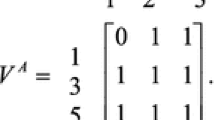Abstract
The fuzzy relation programming problem is a minimization problem with a linear objective function subject to fuzzy relation equations using certain algebraic compositions. Previously, Guu and Wu considered a fuzzy relation programming problem with max-product composition and provided a necessary condition for an optimal solution in terms of the maximum solution derived from the fuzzy relation equations. To be more precise, for an optimal solution, each of its components is either 0 or the corresponding component's value of the maximum solution. In this paper, we extend this useful property for fuzzy relation programming problem with max-strict-t-norm composition and present it as a supplemental note of our previous work.
Similar content being viewed by others
References
Alsina, C., E. Trillas, and L. Valverde. (1983). “On Some Logical Connectives for Fuzzy Sets Theory,” Journal of Mathematical Analysis and Applications 93, 15–26.
De Baets, B., E. Tsiporkova, and R. Mesiar. (1999). “Conditioning in Possibility Theory with Strict Order Norms,” Fuzzy Sets and Systems 106, 221–229.
Di Nola, A., S. Sessa, W. Pedrycz, and E. Sanchez. (1989). Fuzzy Relational Equations and Their Applications in Knowledge Engineering. Dordrecht: Kluwer Academic Press.
Fang, S.-C. and G. Li. (1999). “Solving Fuzzy Relation Equations with a Linear Objective Function,” Fuzzy Sets and Systems 103, 107–113.
Guu, S.-M. and Y.-K. Wu. (2002). “Minimizing a Linear Objective Function with Fuzzy Relation Equation Constraints,” Fuzzy Optimization and Decision Making 1(4), 347–360.
Höhle, U. (1978). “Probabilistic Uniformization of Fuzzy Topologies,” Fuzzy Sets and Systems 1, 311–332.
Iancu, I. (1999). “Connectives for Fuzzy Partitions,” Fuzzy Sets and Systems 101, 509–512.
Jenei, S. (1998). “On Archimedean Triangular Norms,” Fuzzy Sets and Systems 99, 179–186.
Lee, H.-C. and S.-M. Guu. (2003). “On the Optimal Three-tier Multimedia Streaming Services,” Fuzzy Optimization and Decision Making 2(1), 31–39.
Loetamonphong, J. and S.-C. Fang. (2001). “Optimization of Fuzzy Relation Equations with Maxproduct Composition,” Fuzzy Sets and Systems 118, 509–517.
Lu, J. and S.-C. Fang. (2001). “Solving Nonlinear Optimization Problems with Fuzzy Relation Equations Constraints,” Fuzzy Sets and Systems 119, 1–20.
Menger, K. (1942). “Statistical Metrics,” Proc. Natl. Acad. Sci., USA 28, 535–537.
Pedrycz, W. (1985). “On Generalized Fuzzy Relational Equations and their Applications,” Journal of Mathematical Analysis and Applications 107, 520–536.
Sanchez, E. (1976). “Resolution of Composite Fuzzy Relation Equations,” Information and Control 30, 38–48.
Sanchez, E. (1977). “Solutions in Composite Fuzzy Relation Equations,” In M.M. Gupta, G.N. Saridis and B.R. Gaines (eds.), Fuzzy Automata and Decision Processes, 221–234. North Holland, New York.
Wang, P.Z., D.Z. Zhang, E. Sanchez and E.S. Lee. (1991). “Latticized Linear Programming and Fuzzy Relation Inequalities,” Journal of Mathematical Analysis and Applications 159(1), 72–87.
Wang, S., S.-C. Fang, and H.L.W. Nuttle. (2003). “Solution Sets of Interval-valued Fuzzy Relational Equations,” Fuzzy Optimization and Decision Making 2(1), 41–60.
Wu, Y.-K. S.-M. Guu and J. Y.-C. Liu. (2002). “An Accelerated Approach for Solving Fuzzy Relation Equations with a Linear Objective Function," IEEE Transactions on Fuzzy Systems 10(4), 552–558.
Wu, Y.-K. and S.-M. Guu. (2003). “Fuzzy Relation Programming with Max-min Composition,” Working paper, Department of Business Administration, Yuan Ze University.
Zimmermann, H.-J. (1991). Fuzzy Set Theory and Its Applications, Second, Revised Edition, Reprinted by Maw Chang Book Company, Kluwer Academic Publisher. Taipei, Taiwan.
Author information
Authors and Affiliations
Rights and permissions
About this article
Cite this article
Wu, YK., Guu, SM. A Note on Fuzzy Relation Programming Problems with Max-Strict-t-Norm Composition. Fuzzy Optimization and Decision Making 3, 271–278 (2004). https://doi.org/10.1023/B:FODM.0000036862.45420.ea
Issue Date:
DOI: https://doi.org/10.1023/B:FODM.0000036862.45420.ea




